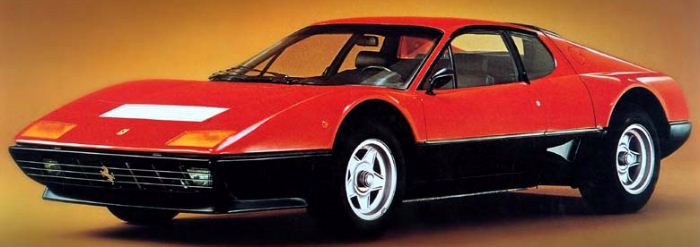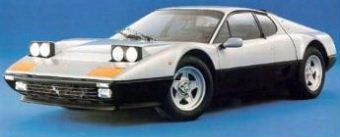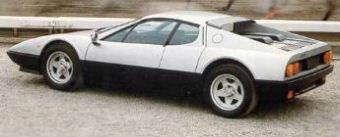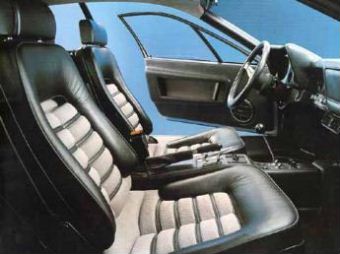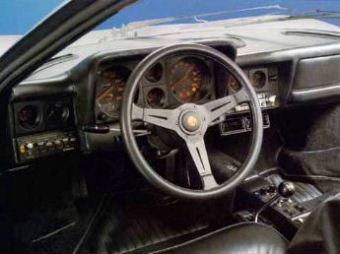|
|
|
< 1970's
1976 Ferrari Berlinetta Boxer In 1971 Enzo Ferrari and long-time stylist Sergio Pininfarina revealed the 365 GT4/BB at the Turin Auto Show. The car was the hit of the event. With some lateral thought and
brilliant development, Ferrari ushered in a new paradigm at the top of its product range. Even before the first production model hit the streets in 1973, the BB - for
Berlinetta Boxer - became the supercar of its era, an icon of the carefree 1970s that remains vastly desirable in the 21st Century. Enhancing North American interest was
Ferrari's uncompromising view of the relationship between US and Canadian government regulations and the purity of his sports cars: the former would not dictate the latter. As
a result, the 365 GT4/BB and its successors, the 512 BB and 512 BBi, were never officially imported or sold in North America. Nonetheless, enthusiasts could not be kept
away from the car and a good many were brought over, legalised, and continue to thrill drivers today
The body of the Boxer was designed for strength and efficiency, its extreme beauty following from these traits. The body of a car should not simply cover the chassis and
cabin, it should interact with them to form a whole. With luck, the design makes a bold and striking statement. In all of these areas, the Boxer was supremely successful. The
car was long, low, and sleek. This impression was accentuated on production cars by use of the 'Boxer colour scheme' featuring matte black below the beltline. The nose
curved up from the ground in contemporary sports-racing car style. Great emphasis was placed on passenger comfort, the cabin and door openings were as large as practically
possible, and a large 'greenhouse' offers excellent outward vision and light, particularly given the buttresses extending over the rear wheels to enclose the deck.
In normal Ferrari practice, the Boxer's chassis is primarily formed from steel tubes. Unusually, the tubes were a mixture of round- and square-section, depending on the needs of the chassis at a given point. The cabin formed a semi-monocoque with tube sub-frames at the front and rear to mount the drivetrain and suspension. The floor and other stress-bearing interior panels were made of aluminum or galvanized steel sandwiched within fibreglass; a virtually non-corrodable combination. The body was likewise formed from galvanized steel, fibreglass, and alloys where appropriate. Pininfarina was daring in the use of a rear-hinged rear deck. Access to the engine and drivetrain was aided by the fact that the entire rear body of the car opened, while the car's bonnet lid, which comprised much of the fore-section, lifted forward in clamshell fashion. The Boxer was a rigid, strong car offering a combination of superb handling and secure comfort. One advantage of a 'boxer' engine was that it can be mounted very low in a chassis. The unusual design of the transmission, beneath the engine, raised the centre of gravity but allowed for both a smaller car and a spacious cabin. The combination engine-transmission was a singularly compact mass that could be exactly placed within its chassis. Weight distribution is a nearly ideal and easily controlled 43-57, with the bias to the rear. The 512 BB and BBi have a slightly different front-rear weight distribution of 40-60. The otherwise unaltered suspension was retuned to balance this change. 365 GT4/BB A by-product of Ferrari's desire to perfect its first attempt at a Flat-12 mid-engined road car was a firm intention that the car would hold the road within the limits of the
average driver. For this reason the chassis was provided with a superb and perhaps overbuilt suspension. Under no circumstances was an average driver to be taken by
surprise with a sudden, rapid oversteer. For all its power, the Boxer was a benign handler The sensuous Pininfarina design and the powerful Ferrari engine were the things which superficially defined the Boxer. The car was really set apart, however, by its surprising degree of comfort. The 365 GT4/BB was designed as a Gran Turismo so the cabin was made spacious, the windows made large, the rearward vision excellent, and the suspension compliant. The Boxer's interior changed little over the model's life. Production 365 GT4/BB had rounded, highly supportive, thin-shelled seats of pleated leather, designed to breathe. The interior matched the seats, with simplicity being the watchword. The steep rake of the windscreen dictated a deep dashboard, surmounted by ventilation nozzles. The instrument binacle was square and contained small oil pressure and coolant temperature guages with a large 320Km/H speedometer and an equally large 10,000rpm tachometer. Smaller binacles hung on either side of the main one, angled towards the driver. All guages were orange on black, easily seen behind the traditional three-spoke Momo wheel. Without a transmission intruding on the cabin, the console between the seats was slim and low. At the driver's right, surmounted by a polished gate, protruded the long and slender gear shifter with spherical grip. Behind the seats were modest leather-lined storage racks. The 512 BB and 512 BBi interiors were essentially unchanged from that of the 365 GT4/BB
Specifications
|
||||||||||||||||||||||||||||||||||||||||||||||||||||||||||||||||||||||||||||||||||||||||||||||||||||||||||||||||||||||||||||||||||||||||||
Dimensions | |
Length | 171.7 in |
Width | 70.9 in |
Height | 44.1 in |
Wheelbase | 98.4 in |
Front track | 59.1 in |
Rear track | 59.5 in |
Weight (Dry) | 2724 lbs |
Wheels front | 7.5L x 15 |
Wheels rear | 7.5L x 15 |
Tires front | 215/70 VR 15 |
Tires rear | 215/70 VR 15 |
| |
180° alloy V12 mounted longitudinally rear amidship | |
Displacement | 4390cc |
Bore & Stroke | 81mm x 71mm |
Compression | 8.8:1 |
Fuel Delivery | Carburettors |
Fuel System | 4 x 3 choke Weber 40IF3C |
Ignition | Marelli Dinoflex AEC 104BK |
Maximum Power | 360bhp @ 7500 rpm |
Maximum Torque | 311lb-ft @ 4500 rpm |
Specific Output | 71 bhp / liter |
512 BB
Dimensions | |
Length | 173.3 in |
Width | 72.0 in |
Height | 44.1 in |
Wheelbase | 98.4 in |
Front track | 59.1 in |
Rear track | 61.5 in |
Weight (Dry) | 3084 lbs |
Wheels front | 7.5L x 15 |
Wheels rear | 9L x 15 |
Tires front | 215/70 VR 15 |
Tires rear | 225/70 VR 15 |
| |
180° alloy V12 mounted longitudinally rear amidship | |
Displacement | 4942cc |
Bore & Stroke | 82mm x 78mm |
Compression | 9.2:1 |
Fuel Delivery | Carburettors |
Fuel System | 4 x 3 choke Weber 40IF3C |
Ignition | Marelli Dinoflex AEC 104BK |
Maximum Power | 340bhp @ 6800 rpm |
Maximum Torque | 331lb-ft @ 4300 rpm |
Specific Output | 69 bhp / liter |
512 BBi
Dimensions | |
Length | 174.0 in |
Width | 72.0 in |
Height | 44.7 in |
Wheelbase | 98.4 in |
Front track | 59.1 in |
Rear track | 61.5 in |
Weight (Dry) | 3800 lbs |
Wheels front | 7.5L x 15 |
Wheels rear | 9L x 15 |
Tires front | 215/70 VR 15 |
Tires rear | 225/70 VR 15 |
| |
180° alloy V12 mounted longitudinally rear amidship | |
Displacement | 4942cc |
Bore & Stroke | 82mm x 78mm |
Compression | 9.2:1 |
Fuel Delivery | Fuel Injection |
Fuel System | Bosch K-Jetronic |
Ignition | Bosch K-Jetronic |
Maximum Power | 340bhp @ 6000 rpm |
Maximum Torque | 333lb-ft @ 4600 rpm |
Specific Output | 69 bhp / liter |
< 1970's
|
The listed details are those published by Ferrari at the model's presentation. |
|
|
|
